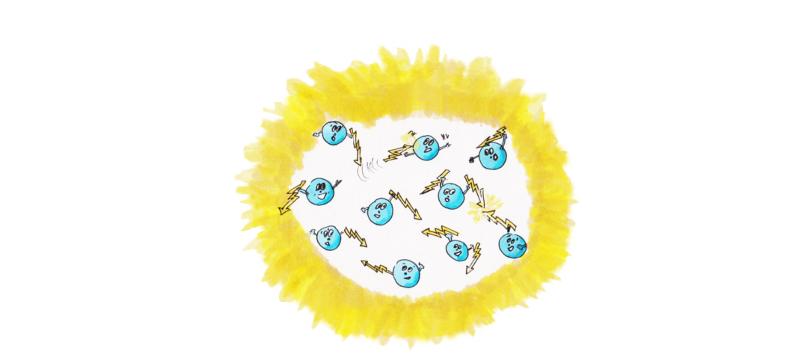Redox reactions (OVR), or redox (sok. English redox, from reduction-oxidation — reduction-oxidation) — counter-parallel chemical reactions occurring with varying degrees oxidation of atoms that are part of reacting substances (or ions of substances), realized by redistribution electrons between the oxidizer atom (acceptor) and the reducing atom (donor).
Example
Example of redox reaction:
2Na(tv) + Cl2(g) → 2NaCl(tv)
Sodium atoms are oxidized to sodium cations Na+ (Na→ Na+ + 1e-), chlorine atoms are reduced to anions Cl- (Cl2 + 2e- → 2Cl-), these reactions occur simultaneously.
Oxidation state
In a neutral atom, the number of electrons is numerically equal to the electric charge of the atom. The degree of oxidation is conditional the designation of the difference between the number of electrons of a given atom and the number of electrons in the neutral state. Degree of oxidation it is indicated by a number and a plus or minus sign above the name of the atom. Plus is put when the charge of the atom is mathematically positive, minus - if negative. For example, calcium - in the neutral state has 20 electrons. Ca+2 is a calcium ion with a degree of oxidation is "+2", i.e. this cation has 18 electrons.
A simple substance is a substance whose molecules consist of identical atoms, for example O, O2, O3 and others. The oxidation state of an atom of a simple substance is always zero.
Metals of the first and second groups have an oxidation state of 1 and 2, respectively.
In compounds, fluorine always has an oxidation state of "-1". Oxygen in most compounds has an oxidation state of "-2", except peroxides in which the oxidation state is -1: O-. Hydrogen has an oxidation state of "-1" in metal hydrides (NaH, CaH2, and others), in other cases hydrogen has an oxidation state of "+1".
Oxidation and reduction
The process in which a substance gives up electrons is called oxidation - the degree of oxidation increases. Reverse process - the acceptance of electrons is called restoration. Both processes occur simultaneously: as a result oxidation of one element is reduced by another.
As a reducing agent, the following are most often used:
- Metals
- Hydrogen
- Coal
- Carbon monoxide (II) (CO)
- Hydrogen sulfide (H2S)
- Sulfur oxide (IV) (SO2)
- Sulfurous acid H2SO3 and its salts
- Hydrofluoric acids and their salts
- Metal cations in lower oxidation states: SnCl2, FeCl2, MnSO4, Cr2(SO4)3
- Nitric acid HNO2
- Ammonia NH3
- Hydrazine NH2NH2
- Nitric oxide(II) (NO)
- Cathode during electrolysis
As an oxidizer, the following are used:
- Halogens
- Potassium Permanganate(KMnO4)
- Potassium manganate (K2MnO4)
- Manganese (IV) oxide (MnO2)
- Potassium Dichromate (K2Cr2O7)
- Potassium chromate (K2CrO4)
- Nitric acid (HNO3)
- Concentrated sulfuric acid solution (H2SO4)
- Copper(II) Oxide (CuO)
- Lead(IV) Oxide (PbO2)
- Silver Oxide (Ag2O)
- Hydrogen peroxide (H2O2)
- Ferric(III)Chloride (FeCl3)
- Bertollet's salt (KClO3)
- Anode during electrolysis
There are also substances that can be both oxidizing agents and reducing agents, depending on the conditions of the reaction. Basically, these are substances with atoms in an intermediate degree of oxidation:
- Sulfur (IV) oxide (SO2)
- Sulfurous acid H2SO3 and its salts
- Hydrogen peroxide (H2O2)
- Nitric acid HNO2 and its salts
Redox equation
The redox reaction (from English redox - reduction–oxidation) is equalized in two stages: the reaction is divided into two half-reactions - oxidation and reduction, each of them mathematically it is equalized relative to the mass of the substance and then by the number of electrons, then both reactions are combined, equalizing the number of electrons in both reactions.
Let's look at the example of the reaction
Fe2+(r-r) + I2 (tv) ↔ Fe3+ + I-(r-r)
1. Let's break down the reaction:
Fe2+ → Fe3+— oxidation
I2 → I- recovery
2. Equalize by mass:
Fe2+ - e-→ Fe3+— oxidation
I2 + 2e- → 2I- recovery
3. Here is the equation:
2Fe2+(r-r) + I2 (tv) ↔ 2Fe3+ + 2I-(r-r)
Terms used
- Redox reaction
- chemical reactions occurring with a change in the degrees of oxidation of the atoms that make up the reacting substances realized by the redistribution of electrons between the oxidizer and the reducing agent.
- Oxidation state
- the symbol of the difference between the number of electrons of a given atom and the number of electrons in the neutral state
- Oxidation
- The process in which molecules give up electrons
- Recovery
- The process in which molecules accept electrons



